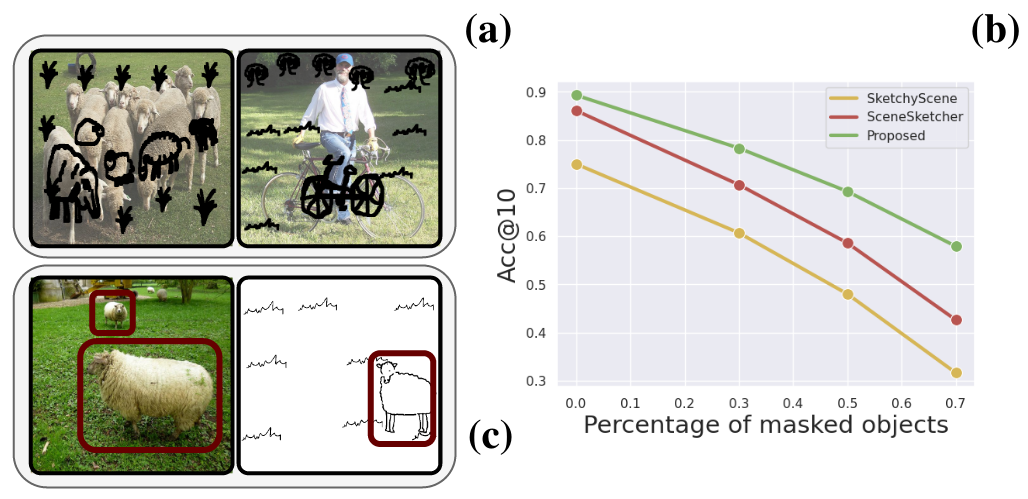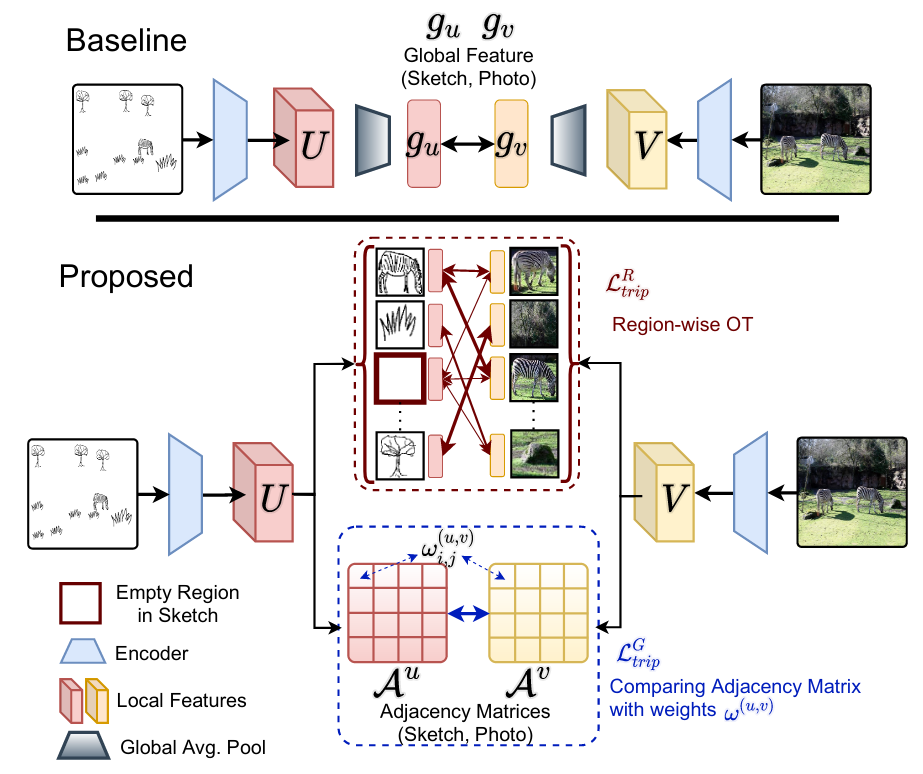A simple set-based approach using optimal transport (OT) to model cross-modal region associativity in a partially-aware fashion. We improve upon OT to further account for holistic partialness by comparing weighted intra-modal adjacency matrices.
Partially Does It: Towards Scene-Level FG-SBIR with Partial Input
Pinaki Nath Chowdhury, Ayan Kumar Bhunia, Viswanatha Reddy Gajjala, Aneeshan Sain, Tao Xiang, Yi-Zhe Song
SketchX, Center for Vision Speech and Signal Processing
University of Surrey, United Kingdom
Published at CVPR 2022
Abstract
We scrutinise an important observation plaguing scene-level sketch research – that a significant portion of scene sketches are “partial”. A quick pilot study reveals: (i) a scene sketch does not necessarily contain all objects in the corresponding photo, due to the subjective holistic interpretation of scenes, (ii) there exists significant empty (white) regions as a result of object-level abstraction, and as a result, (iii) existing scene-level fine-grained sketch-based image retrieval methods collapse as scene sketches become more partial. To solve this “partial” problem, we advocate for a simple set-based approach using optimal transport (OT) to model cross-modal region associativity in a partially-aware fashion. Importantly, we improve upon OT to further account for holistic partialness by comparing intra-modal adjacency matrices. Our proposed method is not only robust to partial scene-sketches but also yields state-of-the-art performance on existing datasets.
Motivation

(a): Scene sketches exhibit abstraction on global scene configuration as shown by overlapping sketches on top of their corresponding photos. (b): Existing scene-level FG-SBIR methods collapse as scene sketches become more partial. (c): There are significant empty (white) regions. Also, the sketch of a sheep in the scene might correspond to that in the centre of photo. This calls for a solution modelling region-wise associativity.
Network Architecture

Illustration of our proposed method for scene-level FG-SBIR. Existing baselines typically use Global Average Pooling (GAP) on the convolutional feature-map. This loses localised region-specific feature representation necessary for “partial” scene sketches. Our proposed method models partially-aware region-wise associativity to solve this “partial” problem using: (i) set-based distance of local feature maps using optimal transport (\(\mathcal{L}^{R}_{trip}\)), (ii) a weighted cross-modal comparison of region adjacency matrix to capture holistic scene configuration (\(\mathcal{L}^{G}_{trip}\)).
Code
The code is available at: https://github.com/pinakinathc/partially-does-it
The main contribution of this paper – a new distance metric for FG-SBIR that computes a loss on sets of local feature is also given in Supplemental Section A.
Instructions to Execute the code
python main.py
TODO
Add a detailed instruction to run the code.
Citation/Bibtex
@inproceedings{partially-does-it,
title={Partially Does It: Towards Scene-Level FG-SBIR with Partial Input},
author={Pinaki Nath Chowdhury, Ayan Kumar Bhunia, Viswanatha Reddy Gajjala, Aneeshan Sain, Tao Xiang, Yi-Zhe Song},
booktitle={The IEEE Conference on Computer Vision and Pattern Recognition (CVPR)},
month={June},
year={2022}
}
Social Media
"Partially Does It: Towards Scene-Level FG-SBIR with Partial Input", CVPR 2022
— Pinaki N Chowdhury (@pinaki_nc) June 21, 2022
Find me at Poster session 1.1, Number 235a.@cvssp_research #CVPR22 #NewOrleans #sketch
Partially Does It: Towards Scene-Level FG-SBIR with Partial Inputhttps://t.co/lfpG9JYtT0
— DeepTweet (@DeepL_Tweet) April 19, 2022
Partially Does It: Towards Scene-Level FG-SBIR with Partial Input. Pinaki Nath Chowdhury, Ayan Kumar Bhunia, Viswanatha Reddy Gajjala, Aneeshan Sain, Tao Xiang, and Yi-Zhe Song https://t.co/wMhMCrQci8
— cs.CV Papers (@arxiv_cs_cv_pr) March 29, 2022